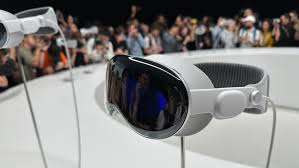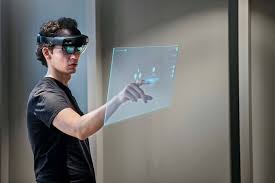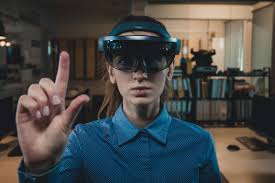
For years, augmented reality (AR) was seen as a futuristic dream, limited to sci-fi movies and experimental gadgets. But in 2025, AR has quietly started blending into our daily lives — thanks largely to the rise of AR glasses.
With companies like Apple, Meta, Samsung, and Xiaomi leading the charge, AR glasses are no longer just bulky prototypes or niche gaming accessories. They’re becoming practical, stylish tools that are changing the way we work, learn, shop, and socialize.
Here’s a closer look at how AR glasses are being used today in real-world settings.

1. Hands-Free Navigation and Information
AR glasses now offer real-time navigation overlaid directly onto your field of view. Whether you’re walking through a busy city or driving a car, visual directions appear as arrows floating in the real world, making it easier — and safer — to find your way.
Beyond navigation, AR glasses can instantly display:
– Restaurant reviews when looking at a café
– Flight information when entering an airport
– Weather updates based on your location
It’s like having a personalized heads-up display, always available, without having to pull out a smartphone.
2. Enhancing Work and Productivity
In 2025, AR glasses are becoming essential tools in several industries:
– Healthcare: Surgeons use AR overlays during operations for real-time imaging and vital stats without looking away from the patient.
– Manufacturing: Technicians view step-by-step repair instructions while working on machinery, boosting efficiency and reducing errors.
– Remote Collaboration: Workers wearing AR glasses can collaborate with remote teams, sharing a live view and annotating in real time — making it feel as if everyone’s in the same room.
Even in office settings, AR glasses are replacing multiple monitors by projecting virtual screens around your workspace.
3. Shopping and Retail Experiences
Augmented reality is revolutionizing shopping both online and offline.
– Virtual Try-Ons: Look at a pair of shoes or glasses and see how they would appear on your body without ever putting them on.
– Product Information: Simply glance at an item on a store shelf to see specifications, customer reviews, and price comparisons.
– AR Shopping Guides: Navigate massive malls or department stores using in-glass AR wayfinding.
Retailers are leveraging AR glasses to blend physical and digital shopping into a seamless experience, reducing friction for customers.
4. Education and Training
AR glasses are powerful educational tools today.
– Interactive Learning: Students studying history can see 3D reconstructions of ancient sites layered onto their environment.
– STEM Education: AR apps allow complex concepts — like DNA structure or physics simulations — to be visualized and interacted with.
– Workforce Training: New employees can follow holographic training modules hands-free, learning faster and with fewer mistakes.
By making learning more engaging and intuitive, AR is helping both students and professionals absorb information more effectively.
5. Social and Entertainment Experiences
Social interactions are evolving too:
– AR Messaging: Receive and read messages mid-conversation without looking away or pulling out your phone.
– Shared AR Worlds: Friends wearing AR glasses can see shared digital objects, play games, or experience collaborative storytelling.
– Live Events: At concerts or sports games, AR glasses can show live stats, player profiles, or exclusive content layered over the real-world experience.
Entertainment companies are investing heavily in AR-exclusive content, aiming to make shows, games, and concerts more immersive than ever.

Challenges Still Ahead
Despite the impressive progress, AR glasses face a few challenges:
– Battery Life: Many current models still struggle to last a full day of active use.
– Privacy Concerns: Widespread AR recording and facial recognition capabilities raise serious ethical questions.
– Social Acceptance: While designs are improving, some people are still wary of interacting with someone wearing AR glasses.
Solving these issues will be crucial to pushing AR glasses even further into the mainstream.
Final Thoughts
In 2025, AR glasses have moved well beyond the novelty stage. They are becoming tools that improve navigation, enhance work, transform shopping, elevate learning, and redefine entertainment.
The real magic of AR today isn’t just in what it can do — it’s in how naturally it’s beginning to fit into everyday life. As technology continues to miniaturize, get smarter, and become more socially accepted, AR glasses are on track to be as common as smartphones were a decade ago.
The future is no longer something you look at through a screen — it’s becoming something you see all around you.
